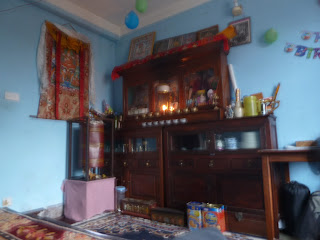*disclaimer* this blog post, and perhaps more to follow, are quite long. Its an account of my trip as much for my benefit as that of the reader, so read what you wish and ignore the rest. I hope you find it interesting- enjoy!
Tashi delek from Boudha , Nepal
I arrived in Kathmandu on Saturday, January 29th. Looking out my window of the Delhi-departed airplane, I my eyes fell on their first glimpse of the Himalayan Mountains
As the plane dropped low below the smog, the foothills came into view, giving way to a wide, dusty valley, stacked flat buildings reaching up out of the dirt. These mountains reminded me a bit of the San Gabriels backing highway 134 in Eagle Rock, CA. I wondered: would these hills, too, become the source of direction? Could I navigate the valley, find my way home by the different jutting peaks and dark patches of trees like their smaller Californian counterparts? Only time would tell how much this foreign place could become home.
Disembarking the airplane I first took notice of the schoolhouse-like airport, its structure made of the same red bricks that would come to define so much of Kathmandu . A burgeoning metropolis, every building seems to be under perpetual construction, the infrastructure far behind its booming population. Our bus rattled by speeding traffic, the honking of horns warning everyone of everyone else, line-less roads a rush of traffic, motorbikes, and pedestrians. Trash lines every street, building, and water source, litter preferable to burning, which adds more poison to the already ghastly air pollution.
A note to Angelinos: LA smog is a fresh sea breeze compared to Kathmandu , even on the worst days. Take the Santa Ana Kathmandu
Despite the air, which forces many to wear unsightly face-masks, a constant visual reminder of filth, the city is like a living festival. In Swayambhu, where our three day orientation took place, activity centers around the grand Swayambhu stupa, a giant temple which sits on top of a hill protruding out of the valley laced with hundreds and hundreds of prayer flags. Each day at dawn hundreds of Nepali, Tibetan, and Nawari Buddhists circumambulate the mount, climbing to the top to spin golden prayer wheels and say prayers and receive blessings. Some come from far away, making kora on an auspicious day, prostrating on the street circling the entire base of the mountain, touching prayer formed hands to forehead, lips, and chest before lying flat on the ground to touch forehead to earth. Up above, the site, also called the Monkey Stupa, is home to hundreds of small brown monkeys that clamber among practitioner and tourist, searching for food and posing for pictures. Ancient scripts engraved in stone and gold painted shrines set the backdrop for CD salesmen and exercising youth, an example of the contrast between ancient and modern so apparent in the valley.
At nightfall, the stars and moon are brilliant, despite the fog. Lack of light pollution, due to 14 hour-a-day load-shedding, allows many constellations to take form that I’d never before seen. From the roof of our guest house, I see the Nagarjuna stupa to which we climbed the day before, a seven hour trek straight up from the valley, the top from which one can see Everest, on a clear day.
Today we packed out of the guest house after our third Tibetan class, which, more like a comedy show due to the comedic nature of our two teachers, Mingyru and Thupten, will be our only preparation for our first night of homestays with Tibetan families in Boudha, the Tibetan quarter of
The sun sets outside my window on my first day with my host family. The little one, Zhang-mo, provided endless entertainment at an otherwise very awkward time, the first day of home stays always have been rather uncomfortable in the past. Lhakpa, the matriarch of the family, lends me English meanings to Tibetan words via repetition toward her niece, a gesture meant as much for the education of the little one as for my own benefit. Zhang-mo delights in stealing my phone and wearing my giant shoes around the house. After kora around the Boudha stupa in the center of town we sat down to dinner on a rug laid out on the floor of the living room, two monks in company for the meal. The monks, she explained, are en-route to Dharamsala, and invited as guests in gratitude for the divinations performed last year to heal their sick brother. The monks and sisters chatted away in Tibetan, throwing my name out every now and then, while I showed pictures to their visiting momo-la, grandma, and made faces at Zhang-mo across the way. The dinner of rice, dhal, steamed vegetables, potatoes and tofu (I think due to my student form saying “vegetarian,” as the momo-la was confused as to what it was) filled me up, eaten late to “create heat needed to stay warm while sleeping.” As I lay out on the bench/bed in the shrine room, pictures of deities and His Holiness the Dalai Lama flickering in the light of my candle, I thought back to the snowy pointed roofs of Washington DC and New York, the beach of Capitola, so far away now, such a contrast to the world I’m in. I can only imagine what this next week will bring. Until then, sim shag nang, goodnight!







Everything sounds amazing. It sounds like a splendid adventure and I can't express how jealous I truly am. I can just imagine the awe inspiring mountains and cannot wait to hear what else this time abroad has in store for you. I miss you a lot. But also love thinking about you out there doing your thing. Cuidate :)
ReplyDelete